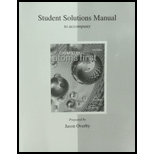
Concept explainers
Interpretation: Definition of coordination covalent bond and its difference from ordinary covalent bond to be explained.
Concept Introduction:
Coordination covalent bond: Chemical substance that contains
Covalent bond: Chemical substance that contains chemical bond in which one of the shared electrons is come from one of the atom and another electron is come from another atom to make corresponding bond is known as covalent bond. Atoms shared their unpaired electrons to make a bond.
To Explain: The term coordination covalent bond and to show how does it differs from normal covalent bond.
Want to see the full answer?
Check out a sample textbook solution
Chapter 6 Solutions
Student Solutions Manual For Chemistry: Atoms First
- What is meant by a chemical bond? Why do atoms form bonds with each other? Why do some elements exist as molecules in nature instead of as free atoms?arrow_forward7.18 In terms of the strengths of the covalent bonds involved, why do combustion reactions release energy?arrow_forwardhy is there an octet rule (and what does actet mean) in writing Lewis structures?arrow_forward
- 7.17 Coulombic forces are often used to explain ionic bonding. Are coulombic forces involved in covalent bonding as well? Explain.arrow_forwardAcrolein is the starting material for certain plastics. (a) Which bonds in the molecule are polar and which are nonpolar? (b) Which is the most polar bond in the molecule? Which atom is the partial negative end of this bond?arrow_forward7.29 When two atoms with different electronegativities form a covalent bond, what does the electron distribution in the bond look like?arrow_forward
- 7.46 Consider the nitrogen-oxygen bond lengths in NO2+ , NO2 , and NO3 . In which ion is the bond predicted to be longest? In which is it predicted to be the shortest? Explain briefly.arrow_forward7.50 Chemical species are said to be isoelectronic if they have the same Lewis structure (regardless of charge). Consider these ions and write a Lewis structure for a neutral molecule that is isoelectronic with each of them, (a) CN , (b) NH4+ . (c) CO32arrow_forwardUsing the standard enthalpy of formation data in Appendix G, determine which bond is stronger: the SF bond in SF4(g) or in SF6(g)?arrow_forward
- 7.24 How many electrons are shared between two atoms in (a) a single covalent bond, (b) a double covalent bond, and (c) a triple covalent bond?arrow_forwardHow many electrons are involved when two atoms in a molecule are connected by a “double bond”? Write the Lewis structure of a molecule containing a double bond.arrow_forwardSketch a graph of the potential energy of two atoms as a function of the distance between them. On your graph, indicate how bond energy and bond distance are defined.arrow_forward
 Chemistry for Engineering StudentsChemistryISBN:9781337398909Author:Lawrence S. Brown, Tom HolmePublisher:Cengage Learning
Chemistry for Engineering StudentsChemistryISBN:9781337398909Author:Lawrence S. Brown, Tom HolmePublisher:Cengage Learning Introductory Chemistry: A FoundationChemistryISBN:9781285199030Author:Steven S. Zumdahl, Donald J. DeCostePublisher:Cengage Learning
Introductory Chemistry: A FoundationChemistryISBN:9781285199030Author:Steven S. Zumdahl, Donald J. DeCostePublisher:Cengage Learning World of Chemistry, 3rd editionChemistryISBN:9781133109655Author:Steven S. Zumdahl, Susan L. Zumdahl, Donald J. DeCostePublisher:Brooks / Cole / Cengage Learning
World of Chemistry, 3rd editionChemistryISBN:9781133109655Author:Steven S. Zumdahl, Susan L. Zumdahl, Donald J. DeCostePublisher:Brooks / Cole / Cengage Learning General Chemistry - Standalone book (MindTap Cour...ChemistryISBN:9781305580343Author:Steven D. Gammon, Ebbing, Darrell Ebbing, Steven D., Darrell; Gammon, Darrell Ebbing; Steven D. Gammon, Darrell D.; Gammon, Ebbing; Steven D. Gammon; DarrellPublisher:Cengage LearningChemistry: Matter and ChangeChemistryISBN:9780078746376Author:Dinah Zike, Laurel Dingrando, Nicholas Hainen, Cheryl WistromPublisher:Glencoe/McGraw-Hill School Pub Co
General Chemistry - Standalone book (MindTap Cour...ChemistryISBN:9781305580343Author:Steven D. Gammon, Ebbing, Darrell Ebbing, Steven D., Darrell; Gammon, Darrell Ebbing; Steven D. Gammon, Darrell D.; Gammon, Ebbing; Steven D. Gammon; DarrellPublisher:Cengage LearningChemistry: Matter and ChangeChemistryISBN:9780078746376Author:Dinah Zike, Laurel Dingrando, Nicholas Hainen, Cheryl WistromPublisher:Glencoe/McGraw-Hill School Pub Co Introductory Chemistry: An Active Learning Approa...ChemistryISBN:9781305079250Author:Mark S. Cracolice, Ed PetersPublisher:Cengage Learning
Introductory Chemistry: An Active Learning Approa...ChemistryISBN:9781305079250Author:Mark S. Cracolice, Ed PetersPublisher:Cengage Learning





